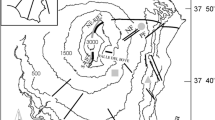Abstract
Radon-222 is inert radioactive gas with a half-life period of 3.8 days, it is a decay product of radium-226. Being escaped from minerals and underground waters into pore space of rocks and soil, it is transported to the surface by diffusion and advection and gone to the atmosphere. When modeling processes of atmosphere radon transport one sets value of radon flux from the surface, depending on contents of radium-226 in rocks and conditions of radon transport in soil, especially on soil porosity and humidity. The impact of radon turbulent transport in the atmospheric boundary layer (ABL) on radon flux density from the surface is estimated in this paper. It is shown that both for stationary state and for typical diurnal variations of the radon volumetric activity (VA) in the ABL, the correction to the radon flux density caused by its turbulent transport in the ABL is negligible (less than 1%) and doesn’t exceed measurement errors. Thus, when calculating radon VA in the ABL it is really possible to set an average value of the radon flux density on the surface as a boundary condition.
Similar content being viewed by others
References
Al-Zoughool, M. and Krewski, D., Health effects of radon: a review of the literature, Int. J. Radiat. Biol., 2009, vol. 85, pp. 57–69.
Anisimov, S.V., Galichenko, S.V., and Aphinogenov, K.V., The radon transport and the atmospheric boundary layer electric state formation, Fundam. Prikl. Gidrofiz., 2016, vol. 9, no. 4, pp. 1–9.
Anisimov, S.V., Galichenko, S.V., Afinogenov, K.V., Makrushin, A.P., and Shikhova, N.M., Radon volumetric activity and ion production in the undisturbed lower atmosphere: ground-based observations and numerical modeling, Izv., Phys. Solid Earth, 2017, no. 1, pp. 147–161.
Cicerone, R.D., Ebel, J.E., and Beitton, J., A systematic compilation of earthquake precursors, Tectonophysics, 2009, no. 476, pp. 371–396.
Dmitriev, E.M., The influence of atmospheric radon transport on radon flux from the Earth’s surface, Materialy nauchnoprakticheskoi konferentsii “Sredneshirotnye geofizicheskie observatorskie nablyudeniya” (Proc. Research and Practice Conference “Midlatitude Geophysical Observatory Measurements”), Borok, October 16–19, 2017, Borok Geophysical Observatory–IFZ RAN–Yaroslavl: Filigran’, 2017a, pp. 18–19.
Dmitriev, E.M., The influence of radon transport in the lower atmosphere on its flux from the Earth’s surface, Materialy 3-i Vserossiiskoi konferentsii “Global’naya elektricheskaya tsep” (Proc. 3rd All-Russia Conference “Global Electric Circuit”), Borok, September 25–29, 2017, Borok Geophysical Observatory–IFZ RAN–Yaroslavl: Filigran’, 2017b, pp. 43–44.
Foken, T., Micrometeorology, Berlin: Springer, 2008.
Hirao, S., Yamazawa, H., and Moriizumi, J., Estimation of global 222Rn flux density from the Earth’s surface, Jpn. J. Health Phys, 2010, vol. 45, pp. 161–171.
Jacob, D.J., Prather, M.J., Rasch, P.J., et al., Evaluation and intercomparison of global atmospheric transport models using 222Rn and other short-lived tracers, J. Geophys. Res., 1997, vol. 102, pp. 5953–5970.
Jacobi, W. and Andre, K., The vertical distribution of Radon 222, Radon 220 and their decay products in the atmosphere, J. Geophys. Res., 1963, vol. 68, no. 13, pp. 3799–3814.
Klovo, A.G., Kupovykh, G.V., and Novikova, O.V., Modeling the processes of subsoil radon transport through the soil and exhalation into the surface atmospheric layer, Izv. Yuzhn. Fed. Univ., Tekh. Nauki, 2011, no. 8, pp. 153–159.
Morozov, V.N., Matematicheskoe modelirovanie atmosferno-elektricheskikh protsessov s uchetom vliyaniya aerozol’nykh chastits i radioaktivnykh veshchestv (Mathematical Simulation of Atmospheric Electrical Processes with Participation of Aerosol Particles and Radioactive Substances), St. Petersburg: RGGMU, 2011.
Nazaroff, W.W., Radon transport from soil to air, Rev. Geophys., 1992, vol. 30, pp. 137–160.
Parovik, R.I., Model for unsteady diffusion–advection of radon in soil–atmosphere, Vestn. KRAUNTs, Ser. Fiz–Mat. Nauki, 2010, no. 1, pp. 39–45.
Parovik, R.I., Il’in, I.A., and Firstov, P.P., Mathematical diffusion model for mass transfer of radon (222Rn) in ground and it exhalation in the surface layer of the atmosphere in 2006, Vestn. KRAUNTs, Ser. Nauki Zemle, 2006, no. 1, pp. 110–114.
Perrier, F. and Girault, F., Harmonic response of soil radon-222 flux and concentration induced by barometric oscillations, Geophys. J. Int., 2013, vol. 195, pp. 945–971.
Schery, S.D. and Huang, S., An estimate of the global distribution of radon emissions from the ocean, Geophys. Rev. Lett., 2004, vol. 31, L19104. doi 10.1029/2004GL021051
Smirnov, V.V., Ionizatsiya v troposfere (Ionization in the Troposphere), St. Petersburg: Gidrometeoizdat, 1992.
Tanner, A.B., Radon migration in the ground: a review, in The Natural Radiation Environment, Adams, J.A.S. and Lowder, W.M., Eds., Chicago: Univ. Chicago, 1964, pp. 161–190.
Wyngaard, J.C., Turbulence in the Atmosphere, New York: Cambridge Univ. Press, 2010.
Wyngard, J.C., Moeng, C.-H., and Weil, J.C., Parameterizing turbulent diffusion in the atmospheric boundary layer, in Studies in Turbulence, Gatski, T.B., Speziale, C.G., and Sarkar, S. (eds.), Berlin: Springer, 1992, pp. 3–16.
Yakovleva, V.S., Diffusion-advective transfer of radon in multilayered geological media, Izv. Tomsk. Politekh. Univ., 2009, vol. 315, no. 2, pp. 67–72.
Yakovleva, V.S., Modeling the effect of the state and variability of the atmosphere and lithosphere on the density of radon and thoron flux from the surface, Izv. Tomsk. Politekh. Univ, 2010, vol. 317, no. 2, pp. 162–166.
Zhuo, W., Iida, T., and Furukawa, M., Modeling radon flux density from the earth’s surface, J. Nucl. Sci. Tech., 2006, vol. 43, no. 4, pp. 479–482.
Author information
Authors and Affiliations
Corresponding author
Additional information
Original Russian Text © E.M. Dmitriev, 2018, published in Fizika Zemli, 2018, No. 5, pp. 115–121.
The article was translated by the authors.
Rights and permissions
About this article
Cite this article
Dmitriev, E.M. Influence of Atmospheric Radon Transport on a Radon Flux from the Surface. Izv., Phys. Solid Earth 54, 775–781 (2018). https://doi.org/10.1134/S106935131805004X
Received:
Published:
Issue Date:
DOI: https://doi.org/10.1134/S106935131805004X




